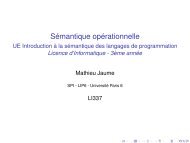A branch and bound algorithm for Choquet ... - DeSIR - LIP6
A branch and bound algorithm for Choquet ... - DeSIR - LIP6
A branch and bound algorithm for Choquet ... - DeSIR - LIP6
You also want an ePaper? Increase the reach of your titles
YUMPU automatically turns print PDFs into web optimized ePapers that Google loves.
A <strong>branch</strong> <strong>and</strong> <strong>bound</strong> <strong>algorithm</strong> <strong>for</strong> <strong>Choquet</strong>optimization in multicriteria problemsLucie Gal<strong>and</strong>, Patrice Perny, <strong>and</strong> Olivier Spanjaard<strong>LIP6</strong>-UPMC, 104 av. du Président Kennedy 75016 Paris, Francefirstname.name@lip6.frSummary. This paper is devoted to the search <strong>for</strong> <strong>Choquet</strong>-optimal solutions inmulticriteria combinatorial optimization with application to spanning tree problems<strong>and</strong> knapsack problems. After recalling basic notions concerning the use of <strong>Choquet</strong>integrals <strong>for</strong> preference aggregation, we present a condition (named preference<strong>for</strong> interior points) that characterizes preferences favouring well-balanced solutions,a natural attitude in multicriteria optimization. When using a <strong>Choquet</strong> integralas preference model, this condition amounts to choosing a submodular (resp. supermodular)capacity when criteria have to be minimized (resp. maximized). Under thisassumption, we investigate the determination of <strong>Choquet</strong>-optimal solutions in themulticriteria spanning tree problem <strong>and</strong> the multicriteria 0-1 knapsack problem. Forboth problems, we introduce a linear <strong>bound</strong> <strong>for</strong> the <strong>Choquet</strong> integral, computablein polynomial time, <strong>and</strong> propose a <strong>branch</strong> <strong>and</strong> <strong>bound</strong> procedure using this <strong>bound</strong>.We provide numerical experiments that show the actual efficiency of the <strong>algorithm</strong>son various instances of different sizes.Key words: Multicriteria combinatorial optimization, <strong>Choquet</strong> integral, <strong>branch</strong><strong>and</strong> <strong>bound</strong>, minimal spanning tree problem, knapsack problem.1 IntroductionIn combinatorial multicriteria optimization problems, many fruitful studies concernthe determination or the approximation of the Pareto set (Ehrgott, 2005). However,in some applications, the size of the instances as well as the combinatorial nature ofthe space of feasible solutions make it impossible to generate the whole set of Paretosolutions (the number of Pareto solutions grows, in the worst case, exponentiallywith the size of the instance (Hamacher <strong>and</strong> Ruhe, 1994) <strong>and</strong> the number of criteria(Rosinger, 1991)). Moreover many solutions in the Pareto set are not relevant <strong>for</strong>the decision maker because they do not match his expectations on some criteria.When a model of decision maker’s preferences is available, it is worth trying tofocus the search directly on the most preferred solutions, rather than generatingthe entire Pareto set (Gal<strong>and</strong> <strong>and</strong> Spanjaard, 2007; Gal<strong>and</strong> <strong>and</strong> Perny, 2007; Pernyet al., 2007). Among the various preference models considered in the literature on
2 L. Gal<strong>and</strong>, P. Perny, O. Spanjaardmulticriteria decision making, the <strong>Choquet</strong> integral is certainly one of the mostexpressive aggregators (see Grabisch et al. (2000)). This model makes it possible totake into account the interactions between criteria <strong>and</strong> to direct the search towardsthe desired compromise solution. Moreover, it is able to reach supported as well asunsupported solutions within the Pareto set.For this reason, we assume in this work that the preferences of the decisionmaker are known <strong>and</strong> represented by a <strong>Choquet</strong> integral. More precisely, to restrictthe search on well-balanced solutions we only consider the subfamily of <strong>Choquet</strong>integral operators with a capacity of a specific shape, namely a submodular capacitywhen criteria have to be minimized <strong>and</strong> a supermodular one when they have to bemaximized (see Chateauneuf <strong>and</strong> Tallon (2002)). Then we investigate the search<strong>for</strong> <strong>Choquet</strong>-optimal solutions in the multicriteria spanning tree problem (the singlecriterion version of which is polynomial) <strong>and</strong> the multicriteria 0-1 knapsack problem(the single criterion version of which is NP-hard).The paper is organized as follows. In Section 2, we recall basic features of <strong>Choquet</strong>integral operators. Then we <strong>for</strong>mulate a condition characterizing preferencesfavouring well-balanced solutions <strong>and</strong> show how it leads to adopt a submodular (resp.supermodular) capacity when criteria have to be minimized (resp. maximized). InSection 3, we propose a <strong>branch</strong> <strong>and</strong> <strong>bound</strong> procedure based on an efficiently computable<strong>bound</strong> on the value of a <strong>Choquet</strong>-optimal solution. In Section 4, we reportnumerical experiments showing the efficiency of the proposed <strong>algorithm</strong>s.2 <strong>Choquet</strong> integral <strong>and</strong> well-balanced solutionsWe consider alternatives that are valued according to multiple criteria functions c i,i ∈ Q = {1, . . . , q}. Without loss of generality, we assume here that the per<strong>for</strong>manceson criteria functions are integer. Every alternative is there<strong>for</strong>e characterizedby a vector of per<strong>for</strong>mances in N q . A popular approach to compare vectors of per<strong>for</strong>manceis to use an aggregation function that associates each alternative with asingle scalar value. The <strong>Choquet</strong> integral (<strong>Choquet</strong>, 1953) is an aggregation functionthat generalizes the notion of average when weights are represented by a capacity.Definition 1 A capacity is a set function v : 2 Q → [0, 1] such that:• v(∅) = 0, v(Q) = 1• ∀A, B ∈ 2 Q such that A ⊆ B, v(A) ≤ v(B)For any subset A ⊆ Q, v(A) represents the importance of coalition A. Let us nowrecall some definitions about capacities.Definition 2 A capacity v is said to be supermodular when v(A ∪ B) + v(A ∩ B) ≥v(A) + v(B) <strong>for</strong> all A, B ⊆ Q, <strong>and</strong> submodular when v(A ∪ B) + v(A ∩ B) ≤ v(A) +v(B) <strong>for</strong> all A, B ⊆ Q. A capacity v is said to be additive when it is supermodular<strong>and</strong> submodular simultaneously.Note that when v is additive, it is completely characterized by v i = v({i}), i =1, . . . , q since v(A) = P i∈Avi <strong>for</strong> all A ⊆ Q.
A <strong>branch</strong> <strong>and</strong> <strong>bound</strong> <strong>algorithm</strong> <strong>for</strong> <strong>Choquet</strong> optimization 3Definition 3 To any capacity v, we can associate a dual capacity ¯v defined by¯v(A) = 1 − v(Q \ A) <strong>for</strong> all A ⊆ Q. Obviously, ¯v = v <strong>for</strong> any capacity v.It is well known that ¯v is submodular if <strong>and</strong> only if v is supermodular <strong>and</strong> vice-versa.Note that when v is supermodular, we have v(A)+v(Q\A) ≤ 1, hence v(A) ≤ ¯v(A).In this case, Shapley (1971) has shown that v has a non-empty core, the core beingdefined by:core(v) = {λ ∈ L : v(A) ≤ λ(A) ≤ ¯v(A)}where L is the set of additive capacities. Similarly, when v is submodular, thencore(¯v) = {λ ∈ L : ¯v(A) ≤ λ(A) ≤ v(A)} is non-emtpy since ¯v is supermodular.These results will be used in Section 3.The <strong>Choquet</strong> integral of a vector x ∈ N q with respect to a capacity v is definedby:qXC v(x) =ˆv(X(i) ) − v(X (i+1) )˜ x (i) (1)=i=1qX ˆx(i) − x (i−1)˜v(X(i) ) (2)i=1where (.) represents a permutation on {1, . . . , q} such that 0 = x (0) ≤ x (1) ≤ . . . ≤x (q) , X (i) = {j ∈ Q, x j ≥ x (i) } = {(i),(i + 1), . . ., (q)} <strong>for</strong> i ≤ q <strong>and</strong> X (q+1) = ∅.Note that X (i+1) ⊆ X (i) , hence v(X (i) ) ≥ v(X (i+1) ) <strong>for</strong> all i. The <strong>Choquet</strong> integralgeneralizes the classical notion of average with the following interpretation based onEquation (2): <strong>for</strong> a given vector x = (x 1, . . . , x q), the per<strong>for</strong>mance is greater or equalto x (1) on all criteria belonging to X (1) , which represents a weight of v(X (1) ) = 1,then the per<strong>for</strong>mance is greater or equal to x (2) on all criteria belonging to X (2) ,which represents an increment of x (2) −x (1) with weight v(X (2) ). A similar incrementapplies from x (2) to x (3) with weight v(X (3) ), <strong>and</strong> so on. The overall integral isthere<strong>for</strong>e obtained by aggregation of marginal increments x (i) − x (i−1) weighted byv(X (i) ). Moreover, when v is additive, we have v(X (i) )−v(X (i+1) ) = v({(i)}) <strong>and</strong> C vas defined by Equation (1) boils down to a classical weighted sum. When it is usedwith a non-additive capacity, function C v offers additional descriptive possibilities.In particular, the <strong>Choquet</strong> integral used with a supermodular (resp. submodular)capacity is usually interpreted as modeling complementarities (resp. redundancies)among criteria. It opens new ways to <strong>for</strong>malize preference <strong>for</strong> well-balanced solutions.Preference <strong>for</strong> well-balanced solutions means intuitively that smoothing or averaginga cost vector makes the decision maker better off. A useful <strong>for</strong>malization ofthis idea has been proposed by Chateauneuf <strong>and</strong> Tallon (2002) through an axiomnamed “preference <strong>for</strong> diversification” due to its interpretation in the context ofportofolio management. This axiom can be translated in our framework as follows:Definition 4 (Preference <strong>for</strong> interior points) A preference is said to favourinteriorPpoints if, <strong>for</strong> any x 1 , . . . , x n ∈ N q , <strong>and</strong> <strong>for</strong> all α 1, . . . , α n ≥ 0 such thatni=1αi = 1, we have:[x 1 ∼ x 2 ∼ . . . ∼ x n ] ⇒nXα i x i x k , k = 1, . . . , ni=1
4 L. Gal<strong>and</strong>, P. Perny, O. SpanjaardGraphically, this axiom can be interpreted as follows: given n indifferent pointsin the space of criteria, any point inside the convex hull of the n points is preferred tothem. For example, on Figure 1 (the higher the better on each criterion), assumingthat a, b <strong>and</strong> c are on the same indifference curve (represented by a broken line onthe figure), point d is preferred to them since it is inside the grey triangle definedby vertices a, b, c.a0101bisecting lineb0101d1 0010101indifference curvecFig. 1. Graphical illustration of preference <strong>for</strong> interior points.Interestingly enough, Chateauneuf <strong>and</strong> Tallon (2002) show that, in the contextof <strong>Choquet</strong>-expected utility theory, the above axiom on preference is equivalent tochoosing a concave utility <strong>and</strong> a supermodular capacity v. The direct translationof this result in our framework (where utility functions are restricted to identity)says that we should use a supermodular (resp. submodular) capacity v to exhibitpreference <strong>for</strong> interior points in maximization (resp. minimization) problems.For example, if a teacher is indifferent between three students profiles with gradevectors x = (18, 18, 0), y = (18, 0, 18) <strong>and</strong> z = (0, 18, 18), preference <strong>for</strong> interiorpoints says that he should prefer another student with profile t = (12, 12, 12) to anyof the three others. Such preferences can easily be represented by using a supermodularcapacity function, <strong>for</strong> example v(A) = (|A|/3) 2 <strong>for</strong> all non-empty A ⊆ Q. Weget indeed: C v(x) = C v(y) = C v(z) = 18 × 4 = 8 whereas Cv(t) = 12 which gives9the maximal overall grade <strong>for</strong> t.If we consider now that x, y, z, t are cost vectors (instead of grades) then weshould use a submodular capacity w to minimize C w. For instance, if we choosew = ¯v we get w(A) = (|A|/3)(2 − |A|/3) <strong>for</strong> all non-empty A ⊆ Q. Hence we get:C w(x) = C w(y) = C w(z) = 18× 8 = 16 whereas Cv(t) = 12 which gives the minimal9overall cost <strong>for</strong> t.3 Determination of <strong>Choquet</strong>-optimal solutionsAssuming the decision-maker exhibits preference <strong>for</strong> interior points, we will now investigatethe determination of C v-optimal solutions in multiobjective combinatorial
A <strong>branch</strong> <strong>and</strong> <strong>bound</strong> <strong>algorithm</strong> <strong>for</strong> <strong>Choquet</strong> optimization 5optimization problems. On the basis of results recalled in the previous section, wewill consider the two following cases:case 1. criteria have to be minimized <strong>and</strong> v is submodular;case 2. criteria have to be maximized <strong>and</strong> v is supermodular.In order to illustrate these two different cases, we will now focus on two particularcombinatorial optimization problems that can be <strong>for</strong>mally stated as follows:<strong>Choquet</strong>-optimal spanning tree problem (C v-ST)Input: a finite connected graph G = (V, E), q integer valuation functions c i on E(to minimize), a submodular capacity v;Goal: we want to determine a spanning tree T ∗ ∈ arg min T ∈T C v(c(T )), where Tis the set of spanning trees on G <strong>and</strong> c(T ) = ( P e∈T c1(e), . . . , P e∈T cq(e)).<strong>Choquet</strong>-optimal 0-1 knapsack problem (C v-KP)Input: a finite collection N = {1, . . . , n} of items, where each item j has a positiveweight w j, a maximum weight capacity W , q integer valuation functions c i on N(to maximize), a supermodular capacity v;Goal: we want to determine a subset S ∗ ∈ arg max S∈S C v(c(S)), where S = {S ⊆N : P j∈S wj ≤ W } <strong>and</strong> c(S) = (P j∈S c1(j), . . . , P j∈S cq(j)).In both problems we assume that number q of criteria is <strong>bound</strong>ed.These two problems are NP-hard. For problem C v-KP, this is obvious: sincethe 0-1 knapsack problem is a special case of problem C v-KP (when there isonly one criterion), problem C v-KP is clearly NP-hard. No similar argument exists<strong>for</strong> C v-ST (minimum spanning tree problem) since the single objective versionof the problem C v-ST is polynomially solvable. However, problem C v-ST caneasily be proved NP-hard. Indeed we remark that when using a submodular capacitydefined by v(A) = 1 <strong>for</strong> all non-empty A ⊆ Q <strong>and</strong> 0 otherwise, we getC v(x) = P qi=1ˆx(i) − x (i−1)˜v(X(i) ) = x (q) = max i∈Q x i. Hence the determinationof a <strong>Choquet</strong>-optimal solution reduces to a minmax optimization problem, <strong>and</strong> theminmax spanning tree problem has been proved NP-hard by Hamacher <strong>and</strong> Ruhe(1994).Besides their practical interest, we chose to study these two problems becauseone is an extension of an easy single criterion problem (minimum spanning treeproblem), <strong>and</strong> the other one of a hard single criterion problem (0-1 knapsack problem).Moreover, one is a minimization problem (case 1) whereas the other one is amaximization problem (case 2). Now, we are going to introduce <strong>branch</strong> <strong>and</strong> <strong>bound</strong>procedures <strong>for</strong> these two problems.Branch <strong>and</strong> <strong>bound</strong> procedures <strong>for</strong> <strong>Choquet</strong>-optimization. The <strong>branch</strong>ingpart is specific to each problem <strong>and</strong> will be briefly described at the end of thesection. The <strong>bound</strong>ing part is quite similar <strong>for</strong> both problems. It is grounded on aresult of Schmeidler (1986) which offers a nice intuitive interpretation of the <strong>Choquet</strong>expected utility as the minimum of a family of expected utilities to be maximized.A useful by-product of this result in our context is the following inequality:Proposition 1 If v is supermodular (resp. submodular) then <strong>for</strong> all λ ∈ core(v)(resp. λ ∈ core(¯v)) characterized by coefficients λ i = λ({i}), i = 1, . . . , q, the followinginequality holds: C v(x) ≤ P qi=1 λixi (resp. Cv(x) ≥ P qi=1 λixi) <strong>for</strong> all x ∈ Nq .
6 L. Gal<strong>and</strong>, P. Perny, O. SpanjaardProof. We only prove the result in the case of a maximization with a supermodularcapacity, the proof <strong>for</strong> the minimization case being essentially similar. Sincev is supermodular then core(v) is non-empty <strong>and</strong> <strong>for</strong> all λ ∈ core(v) we havev(X (i) ) ≤ λ(X (i) ) <strong>for</strong> all i. Hence, noticing that x (i) − x (i−1) ≥ 0 <strong>for</strong> all i wehave `x (i) − x (i−1)´v(X(i) ) ≤ `x (i) − x (i−1)´λ(X(i) ) <strong>for</strong> all i. Adding these inequalities,we get: C v(x) = P qi=1`x(i) − x (i−1)´v(X(i) ) ≤ P qi=1`x(i) − x (i−1)´λ(X(i) ) == P qi=1ˆλ(X(i) ) − λ(X (i+1) )˜ x (i) = P qi=1 λ({(i)})x (i) = P qi=1 λixi.Hence, any vector of weights (λ 1, . . . , λ q) ∈ R q + with λi = λ({i}), i = 1, . . . , qwhere λ is an additive capacity in core(v) (resp. core(¯v)) can be used to producea linear upper <strong>bound</strong> (resp. lower <strong>bound</strong>) on values of the <strong>Choquet</strong> integral. Inthe sequel, the set of all such vectors (λ 1, . . . , λ q) ∈ R q + is denoted Λ. The resultabout the non-emptiness of the core (see Section 2) guarantees the existence ofat least a weighting vector (λ 1, . . . , λ q) in Λ. Linearity of the <strong>bound</strong>Phas a majoradvantage. For C v-ST, we have indeed min T ∈T C v(c(T )) ≥ min qP T ∈T i=1λici(T ).Given λ, the value min qT ∈T i=1λici(T ) can be obtained by solving a monocriterionversion of the problem where vector valuations of type (c 1(e), . . . , c q(e))are replaced by P qi=1λici(e). Similarly, <strong>for</strong> Cv-KP, we have maxS∈SPCv(c(S)) ≤max qS∈S i=1λici(S) <strong>for</strong> λ ∈ core(¯v). The two resulting monocriterion problemswill be respectively denoted λ-ST <strong>and</strong> λ-KP hereafter. The optimal solution of λ-STis computed in polynomial time by using Kruskal’s <strong>algorithm</strong>. For problem λ-KP,the exact computation of the optimal solution would require too much processingtime. For this reason, we resort to an upper approximation of the optimal value ofλ-KP computed with the Martello <strong>and</strong> Toth method (Martello <strong>and</strong> Toth, 1975).Optimizing <strong>bound</strong>s. A question naturally arises now to design an efficient <strong>branch</strong><strong>and</strong> <strong>bound</strong> procedure: given an instance of C v-ST (resp. C v-KP), which vector ofweights should we choose inside Λ at each node of the search tree? Clearly, allvectors of weights in Λ do not provide the same value <strong>for</strong> the lower <strong>bound</strong> (resp.upper <strong>bound</strong>), <strong>and</strong> the best choice <strong>for</strong> these weights (i.e., providing the highest lower<strong>bound</strong>, resp. the lowest upper <strong>bound</strong>) depends on the subproblem to deal with. Wenow describe a way to explore the space of possible weights in Λ at each node of the<strong>branch</strong> <strong>and</strong> <strong>bound</strong> procedure. This exploration can be related to the subgradientoptimization <strong>algorithm</strong> used in minmax combinatorial optimization (Murthy <strong>and</strong>Her, 1992; Punnen <strong>and</strong> Aneja, 1995). In case 1, the optimal vector of weights (i.e.,providing the best <strong>bound</strong>) can be obtained by solving the following mathematicalprogram P v:max f(λ) (3)λ∈Rq Xs.t. λ i ≤ v(A) ∀A ⊆ Q, (4)i∈AXλ i = 1, (5)i∈Qλ i ≥ 0 ∀i = 1, . . . , q. (6)where f(λ) is the value of the optimal spanning tree in λ-ST. In case 2, max isreplaced by min in the objective function, “≤” is replaced by “≥” in constraint 4,<strong>and</strong> f(λ) is the value returned by the Martello <strong>and</strong> Toth method applied to λ-KP.Note that, in P v, any vector (λ 1, . . . , λ q) that satisfies constraints 4, 5 <strong>and</strong> 6provides an admissible <strong>bound</strong> (the closer to optimality the better the <strong>bound</strong>). This
A <strong>branch</strong> <strong>and</strong> <strong>bound</strong> <strong>algorithm</strong> <strong>for</strong> <strong>Choquet</strong> optimization 7point is important since the solution method we use <strong>for</strong> P v is iterative <strong>and</strong>, inlimited time, only provides an approximation of the optimal weights. We now explainhow the iterative method operates in case 1 (case 2 is similar). Given that f is aconcave piecewise linear function (since it is the lower envelope of a set of linearfunctions), we solve program P v using Shor’s r-<strong>algorithm</strong> which is available in theSolvOpt library (Kappel <strong>and</strong> Kuntsevich, 2000). This <strong>algorithm</strong> is indeed especiallyconvenient <strong>for</strong> non-differentiable optimization. For maximization (as this is the casehere), the basic principle of the <strong>algorithm</strong> is to build a sequence (λ k ) of points (apoint is here a vector of weights) by repeatedly making steps in the direction ofa subgradient 1 ▽f(λ k ) at the current point (steepest ascent). However, unlike thesubgradient method, every step is made in a dilated space, the dilation directionof which depends on the difference between a subgradient at the current point <strong>and</strong>the one computed at the previous point. At each iteration of the procedure, onesolves a minimum spanning tree problem to determine f(λ k ) = P qi=1 λiyk i , wherey k is the image of the minimum spanning tree computed at iteration k. Subgradient▽f(λ k ) at point λ k is precisely y k . To take into account constraints 4 to 6, a penaltyfunction g is used, i.e. constraints are relaxed <strong>and</strong> one maximizes f(λ) − Rg(λ)instead of f(λ), where R is a positive penalty coefficient <strong>and</strong> g takes a positivevalue if a constraint is violated at point λ, <strong>and</strong> value 0 otherwise. For simplicity,we omit constraints 5 <strong>and</strong> 6 in the presentation. Usually, given a point (λ 1, . . . , λ q),the penalty function would be defined as the maximal residual of the set of violatedconstraints at point λ, which writes max{0, max A⊆S r A} where r A = P i∈A λi−v(A).Instead, in our implementation, we use the sum of the residuals of the set of violatedconstraints at point λ, which writes P r A >0rA (to speed up the convergence). Inorder to compute ▽f(λ k ) − R ▽ g(λ k ) (the subgradient of f − Rg at point λ k ),we have to compute subgradient ▽g(λ k ). Considering constraints 4, subgradient▽g(λ k ) is equal to (|C 1| , . . . , |C q|), where C i denotes the set of violated constraintsinvolving criterion i.Besides, at each node of the search tree, the incumbent (i.e., the current bestsolution) is updated if the <strong>Choquet</strong> value of one of the solutions computed by Shor’sr-<strong>algorithm</strong> is better. Indeed, we take advantage of the property that feasible solutionsare generated when computing the <strong>bound</strong>.Branching scheme. We apply a <strong>branch</strong> <strong>and</strong> <strong>bound</strong> procedure to both problems C v-ST <strong>and</strong> C v-KP. The <strong>branch</strong>ing scheme is very simple: at each node of the <strong>branch</strong> <strong>and</strong><strong>bound</strong>, the problem is separated in two subproblems depending on whether a givenedge (resp. item) is made m<strong>and</strong>atory or <strong>for</strong>bidden. The heuristic to guide the searchis static: be<strong>for</strong>e the beginning of the <strong>branch</strong> <strong>and</strong> <strong>bound</strong>, a preliminary run of Shor’sr-<strong>algorithm</strong> is per<strong>for</strong>med in order to find a vector of weights (λ 1, . . . , λ q), <strong>and</strong> edgese (resp items j) are ranked in increasing (resp. decreasing) order of P qi=1 λici(e)(resp. ( P qi=1λici(j))/wj). The next edge (resp. item) on which to <strong>branch</strong> is thenselected according to this ranking.1 Roughly speaking, a subgradient in non-differentiable optimization plays an analogousrole to the one of the gradient in differentiable optimization.
8 L. Gal<strong>and</strong>, P. Perny, O. Spanjaard4 ApplicationsThe <strong>algorithm</strong>s have been implemented in C++, <strong>and</strong> the experimentations werecarried out on an Intel Pentium Core 2 computer with 2.66Ghz. For C v-ST, weused two types of submodular capacities respectively defined, <strong>for</strong> all sets A ⊆ Q,by v 1(A) =q Pi∈A ωiwhere ωi’s are r<strong>and</strong>omly drawn positive weights, <strong>and</strong>v 2(A) = P B∩A≠∅m(B) where m(B), B ⊆ Q are r<strong>and</strong>omly drawn positive coefficients(Möbius masses) adding up to 1 (Shafer, 1976). For C v-KP, we usedtwo types of supermodular capacities respectively defined, <strong>for</strong> all sets A ⊆ Q, byv 1(A) ′ = ( P i∈A ωi)2 <strong>and</strong> v 2(A) ′ = P B⊆Am(B) with the same notations as above.The experimentations on the <strong>Choquet</strong> optimal spanning tree problem (C v-ST)were per<strong>for</strong>med on complete graphs (cliques). The criteria values on each edge arer<strong>and</strong>omly drawn between 1 <strong>and</strong> 100. The number of criteria is 3, 5 or 8, <strong>and</strong> thenumber of nodes ranges from 10 to 70. For each class of graphs (characterized bythe number of nodes <strong>and</strong> the number of criteria), we solve 50 different instances.Table 1 summarizes the average execution times (in seconds) on these instances.Symbol “–” means that the average execution times exceed 30 minutes.The experimentations on the <strong>Choquet</strong> optimal 0-1 knapsack problem (C v-ST)were also per<strong>for</strong>med on 50 different instances <strong>for</strong> each category. Table 2 shows computationtimes (in sec) obtained on at least 30 different instances <strong>for</strong> each size, withprofits <strong>and</strong> weights r<strong>and</strong>omly drawn between 1 <strong>and</strong> 100, <strong>and</strong> a maximum weightcapacity W equal to 50% of the total weight of the items. The number of itemsranges from 50 to 210. Here again, the number of criteria is 3, 5 or 8.Table 1. Numerical results <strong>for</strong> C v-ST.v 1|V | 3 crit. 5 crit. 8 crit.10 0.02 0.04 0.3215 0.07 0.23 2.0820 0.23 1.47 16.7225 0.83 5.05 69.9230 1.94 15.57 192.5335 3.93 41.82 928.8540 7.35 109.19 –45 18.47 273.34 –50 26.56 297.65 –55 44.63 600.25 –60 75.17 967.42 –65 129.10 – –70 209.10 – –v 2|V | 3 crit. 5 crit. 8 crit.10 0.02 0.10 2.5515 0.11 1.56 47.2220 0.51 7.95 447.7925 1.48 33.69 –30 2.87 196.19 –35 9.15 452.30 –40 24.77 1010.87 –45 37.26 – –50 72.41 – –55 129.20 – –60 290.10 – –65 329.50 – –70 823.40 – –These results show the efficiency of the <strong>branch</strong> <strong>and</strong> <strong>bound</strong> procedures. For example,when capacity v ′ 1 is used, it takes only one minute <strong>for</strong> solving problem C v-KPwith 150 items <strong>and</strong> 8 criteria, <strong>and</strong> only two minutes <strong>for</strong> solving problem C v-ST withcapacity v 1, 65 nodes <strong>and</strong> 3 criteria. Moreover we can observe that the execution
A <strong>branch</strong> <strong>and</strong> <strong>bound</strong> <strong>algorithm</strong> <strong>for</strong> <strong>Choquet</strong> optimization 9Table 2. Numerical results <strong>for</strong> C v-KP.v ′ 1n 3 crit. 5 crit. 8 crit.50 0.61 1.27 6.4270 0.97 3.64 14.4090 2.77 5.81 25.56110 4.16 10.84 26.73130 7.38 15.37 38.96150 11.48 28.22 66.76170 15.46 31.14 71.36190 22.44 35.86 161.25210 36.20 41.15 165.02v 2′n 3 crit. 5 crit. 8 crit.50 1.02 1.97 19.7370 2.00 4.94 37.4090 2.59 9.19 108.24110 6.06 16.40 211.10130 8.85 31.83 397.09150 12.27 64.77 739.43170 25.59 93.98 1021.37190 27.33 135.15 1391.82210 50.04 145.86 –times depend on the capacity. In particular the times are better with capacity v 1(resp. v ′ 1) than with capacity v 2 (resp. v ′ 2). We might explain this observation byremarking that v 2 <strong>and</strong> v ′ 2 are monotone of infinite order, but a more thorough studywould be necessary to confirm this tentative explanation.5 ConclusionWe have presented a general <strong>bound</strong> that can be used <strong>for</strong> the search <strong>for</strong> <strong>Choquet</strong>optimalsolutions in combinatorial problems. This <strong>bound</strong> is valid <strong>for</strong> any multiobjectiveoptimization problem provided we chose a submodular capacity in minization(resp. a supermodular capacity <strong>for</strong> maximization) so as to reflect preference <strong>for</strong>interior points. Given a set of criteria weights (ω 1, . . . , ω q), a possible example ofsuitable capacity is given by v(A) = ϕ( P i∈Aωi) <strong>for</strong> all A ⊆ Q which is supermodularwhenever ϕ(x) ≤ x <strong>and</strong> submodular whenever ϕ(x) ≥ x. Interestingly enough,the <strong>Choquet</strong> integral used with such a capacity is nothing else but the weighted orderedweighted averaging operator (WOWA) considered by Ogryczak <strong>and</strong> Sliwinski(2007) <strong>for</strong> compromise search in continuous multiobjective optimization problems.WOWA operator, also known as Yaari’s model in Economics (Yaari, 1987), is there<strong>for</strong>ea particular case of <strong>Choquet</strong> integral. Hence, the <strong>bound</strong> we introduced in thispaper might be used as well to determine WOWA-optimal operators on combinatorialdomains provided ϕ is compatible with preference <strong>for</strong> interior points. Conversely,the work of Ogryczak <strong>and</strong> Sliwinski (2007) <strong>for</strong> WOWA-optimization on continuousdomains should provide alternative <strong>bound</strong>s <strong>for</strong> C v-KP by relaxing the integralityconstraint.ReferencesChateauneuf, A. <strong>and</strong> Tallon, J. (2002). Diversification, convex preferences <strong>and</strong> nonemptycore in the choquet expected utlity model. Economic Theory, 19, 509–523.<strong>Choquet</strong>, G. (1953). Theory of capacities. Annales de l’Institut Fourier, 5, 131–295.
10 L. Gal<strong>and</strong>, P. Perny, O. SpanjaardEhrgott, M. (2005). Multicriteria Optimization. 2nd ed. Springer-Verlag.Gal<strong>and</strong>, L. <strong>and</strong> Perny, P. (2007). Search <strong>for</strong> <strong>Choquet</strong>-optimal paths under uncertainty.In Proceedings of the 23rd conference on Uncertainty in Artificial Intelligence,pages 125–132, Vancouver, Canada. AAAI Press.Gal<strong>and</strong>, L. <strong>and</strong> Spanjaard, O. (2007). OWA-based search in state space graphswith multiple cost functions. In 20th International Florida Artificial IntelligenceResearch Society Conference, pages 86–91. AAAI Press.Grabisch, M., Murofushi, T., <strong>and</strong> Sugeno, M. (2000). Fuzzy measures <strong>and</strong> integrals.Theory <strong>and</strong> applications. Studies in Fuzziness, Physica Verlag.Hamacher, H. <strong>and</strong> Ruhe, G. (1994). On spanning tree problems with multiple objectives.Annals of Operations Research, 52, 209–230.Kappel, F. <strong>and</strong> Kuntsevich, A. (2000). An implementation of Shor’s r-<strong>algorithm</strong>.Computational Optimization <strong>and</strong> Applications, 15, 193–205.Martello, S. <strong>and</strong> Toth, P. (1975). An upper <strong>bound</strong> <strong>for</strong> the zero-one knapsack problem<strong>and</strong> a <strong>branch</strong> <strong>and</strong> <strong>bound</strong> <strong>algorithm</strong>. European Journal of Operational Research,1, 169–175.Murthy, I. <strong>and</strong> Her, S. (1992). Solving min-max shortest-path problems on a network.Naval Research Logistics, 39, 669–683.Ogryczak, W. <strong>and</strong> Sliwinski, T. (2007). On optimization of the importance weightedOWA aggregation of multiple criteria. In Computational Science <strong>and</strong> Its Applications– ICCSA 2007 , pages 804–817. Lecture Notes in Computer Science.Perny, P., Spanjaard, O., <strong>and</strong> Storme, L.-X. (2007). State space search <strong>for</strong> risk-averseagents. In Twentieth International Joint Conference on Artificial Intelligence,pages 2353–2358.Punnen, A. <strong>and</strong> Aneja, Y. (1995). Minmax combinatorial optimization. EuropeanJournal of Operational Research, 81(3), 634–643.Rosinger, E. E. (1991). Beyond preference in<strong>for</strong>mation based multiple criteria decisionmaking. European Journal of Operational Research, 53(2), 217–227.Schmeidler, D. (1986). Integral representation without additivity. Proceedings of theAmerican Mathematical Society, 97(2), 255–261.Shafer, G. (1976). A Mathematical Theory of Evidence. Princeton University Press.Shapley, L. (1971). Cores of convex games. International Journal of Game Theory,1, 11–22.Yaari, M. (1987). The dual theory of choice under risk. Econometrica, 55, 95–115.


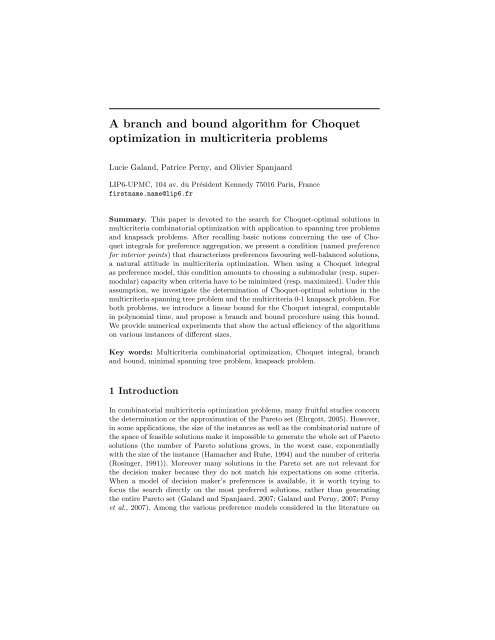
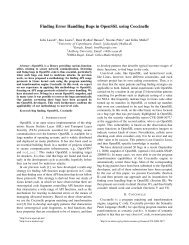


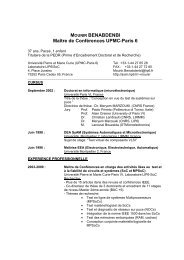
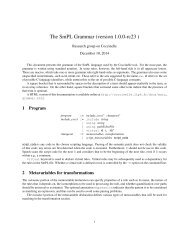
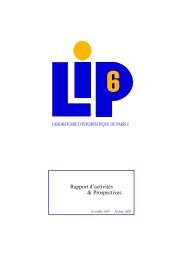
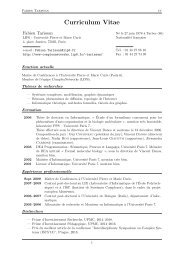


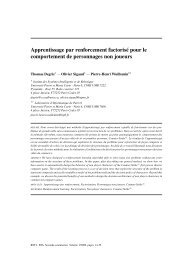
![Proceedings [PDF] - Measurement and Analysis of P2P Activity ...](https://img.yumpu.com/32964521/1/184x260/proceedings-pdf-measurement-and-analysis-of-p2p-activity-.jpg?quality=85)
